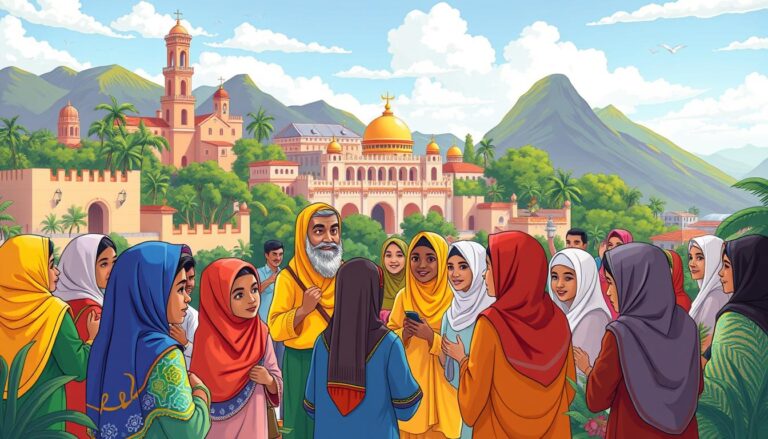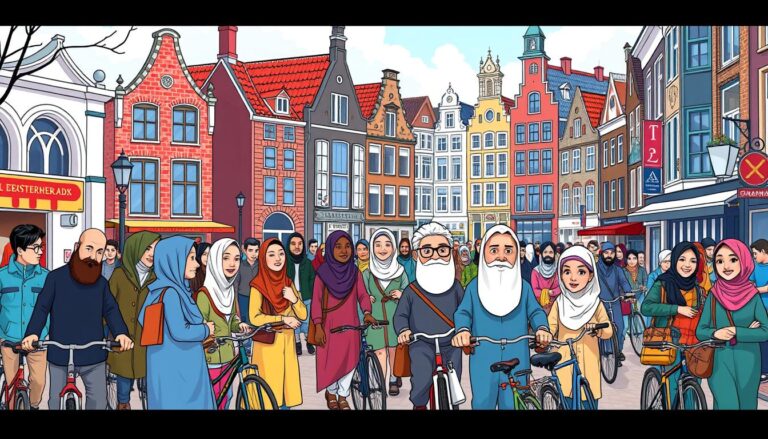Islam in China
Contrary to popular belief, Islam has a long and vibrant history in China, dating back to the 7th century CE. In fact, there are an estimated 17–25 million Muslims in China, making up less than 2 percent of the total population. The largest concentration of these Muslims resides in the northwestern Xinjiang autonomous region, which is home to a significant Uyghur population. Significant Muslim communities can also be found in the regions of Ningxia, Gansu, and Qinghai. Out of China’s 55 officially recognized minority peoples, ten groups are predominantly Sunni Muslim.
Key Takeaways
- Islam has been practiced in China since the 7th century CE.
- There are an estimated 17–25 million Muslims in China, less than 2% of the total population.
- The largest concentration of Muslims is in the Xinjiang autonomous region, home to a significant Uyghur population.
- Significant Muslim populations also reside in the regions of Ningxia, Gansu, and Qinghai.
- Out of China’s 55 officially recognized minority peoples, ten are predominantly Sunni Muslim.
Origins of Islam in China
The Silk Road, a network of extensive inland trade routes that spanned from the Mediterranean to East Asia, has been in use since 1000 BCE and continued for millennia. For more than half of this long period, most of the traders traversing these routes were Muslim, gradually spreading Islam eastward through war, trade, and diplomatic exchanges.
Trade Routes and Early Muslim Settlers
According to Chinese Muslim tradition, Islam was first introduced to China in 616–18 CE by the Companions of the Prophet Muhammad: Sa’d ibn Abi Waqqas, Wahab ibn Abu Kabcha, and another. The introduction of Islam to China mainly occurred through two routes: from the southeast, following an established path to Guangdong, and from the northwest, through the Silk Road.
Arab and Persian Muslim settlers began arriving in China during the Tang dynasty (618-907 CE), establishing communities in coastal cities like Guangzhou, where the Guangzhou Mosque was built in the 7th century CE.
The Arrival of Sa’d ibn Abi Waqqas
According to traditional accounts, Sa’d ibn Abi Waqqas, one of the Companions of the Prophet Muhammad, is credited with introducing Islam to China in the 7th century CE. He is said to have traveled to the capital of the Tang dynasty, Chang’an (now Xi’an), and met with the Emperor, who granted him permission to build China’s first mosque.
“The Silk Road was a network of trade routes that connected the East and West, and it was through these routes that Islam gradually spread to China.”
Tang Dynasty: A Cosmopolitan Era
The Tang dynasty (618-907 CE) was a remarkable era of prosperity and cultural exchange in Chinese history. This period witnessed the flourishing of Arab and Persian Muslim communities within the Tang’s cosmopolitan society. The early Tang era saw intensive contacts with Central Asia, which helped facilitate the introduction of Islam to China.
Arab and Persian Muslim Communities
The first major Muslim settlements in China consisted of Arab and Persian merchants, who established comparatively well-established, albeit somewhat segregated, mercantile communities in the port cities of Guangzhou, Quanzhou, and Hangzhou on China’s southeastern coast, as well as in interior hubs such as Chang’an, Kaifeng, and Yangzhou during the Tang and Song dynasties.
Records indicate that between 651 and 798 CE, Muslim envoys visited China more than 37 times, showcasing the early diplomatic and trade connections between the two regions. By the mid-seventh century, a census taken in 742 CE showed that the foreign population in Canton alone had increased significantly, reaching nearly half of the total registered population, with an estimated 200,000 foreigners residing in the city.
Tragically, the peaceful coexistence of these Muslim communities was disrupted in 878 CE when a rebel leader named Huang Chao led a massacre of Muslims, Jews, Christians, and Zoroastrians in Guangzhou, with estimates of victims ranging from 120,000 to 200,000 people.
“The demand for sugar in Tang China led to Indian envoys bringing two sugar-makers to teach the Chinese how to cultivate sugarcane.”
Despite this setback, the Tang dynasty remained a cosmopolitan era, embracing foreign influences in fashion, cuisine, music, and dance. This openness to cultural exchange helped shape the unique Muslim communities that would continue to thrive in China during the subsequent Song and Yuan dynasties.
Song Dynasty: Muslims in Trade and Commerce
The Song dynasty era witnessed a significant rise in the influence of Muslim traders and merchants within China’s thriving commercial landscape. During this period, the prestigious position of Director General of Shipping was consistently held by a Muslim official, underscoring the essential role they played in the country’s import and export industries.
In 1070, the Song emperor Shenzong invited over 5,300 Muslims from Bukhara to settle in China, with the aim of creating a buffer zone between the Song and the Liao dynasties in the northeast. These Muslim settlers were led by Prince Amir Sayyid “Su-fei-er,” who was revered as the “father” of the Muslim community in China.
One notable figure from this era was Pu Shougeng, a Muslim foreign trader who played a crucial role in assisting the Yuan dynasty’s conquest of the last stronghold of Song power in southern China. Pu Shougeng’s influential position and the prominence of Muslim merchants during the Song dynasty era underscores the integral part they played in the country’s burgeoning trade and commerce.
“For each load of pepper sent to Christendom, a hundred were sent to China,” remarked the famous explorer Marco Polo, highlighting the substantial pepper trade that flourished between China and its trading partners during the Song dynasty.
The Song dynasty saw a remarkable expansion of China’s maritime trade, which for the first time exceeded its overland foreign trade. Chinese ships of the era were technologically advanced and larger than their competitors from India and the Arab world, further contributing to the country’s commercial dominance.
The thriving port of Zaitun (Quanzhou) served as a crucial hub for merchants from India and southern China, importing a vast array of luxury goods, precious stones, and pearls for distribution throughout the Middle Kingdom. This influx of foreign trade and the presence of prosperous Muslim communities were hallmarks of the Song dynasty’s commercial expansion and cosmopolitan character.
Yuan Dynasty: Rise of Muslim Influence
During the Mongol-founded Yuan dynasty (1271–1368), China witnessed a significant influx of Muslims. The Mongols, a minority ruling class, strategically elevated the status of foreign immigrants, including Muslims, Buddhists, Christians, and Jews from West Asia, over the local Khitan and Jurchen populations. This policy allowed Muslims to gain a strong foothold in the administration of the rapidly expanding Mongol empire.
The Mongol Embrace of Foreign Administrators
The Mongols recruited and forcibly relocated hundreds of thousands of Muslim immigrants from Western and Central Asia to help them govern their domains. Muslims headed many corporations and institutions in China during the early Yuan period, wielding significant influence. They were also actively involved in calendar-making, astronomy, and other intellectual pursuits.
Architectural Marvels of Muslim Architects
One notable example of Muslim influence during the Yuan dynasty was the architect Yeheidie’erding (Amir al-Din), who blended Han architectural traditions with his own expertise to design the capital city of the Yuan dynasty, Dadu (present-day Beijing). This collaboration between Mongol rulers and skilled Muslim architects resulted in the creation of architectural marvels that showcased the cultural exchange and integration taking place in China at the time.
“The Mongols, a minority in China, gave foreign immigrants, such as Buddhists, Christians, Muslims and Jews from West Asia an elevated status over locals including Khitan and Jurchens as part of their governing strategy, thus giving Muslims a heavy influence.”
Ming and Qing Dynasties: Integration and Conflict
The Ming (1368-1644) and Qing (1644-1911) dynasties witnessed a complex relationship between Islam and the Chinese state. While Muslims experienced periods of integration, they also faced periodic religious suppression and revolts.
Suppression and Periodic Revolts
During the Ming dynasty, mosques in Guangzhou and Xi’an were not built until the early part of the era. Chinese Muslims adapted by adopting Chinese names and language to blend in. However, the Qing dynasty’s annexation of northwestern territories in the 1750s led to deteriorating relations with the Muslim community.
Five major Muslim rebellions occurred during the Qing dynasty in northwestern China and Yunnan. These included the Jahriyya revolt, the Panthay Rebellion (1856–1873), the First Dungan Revolt (1862–1877), and the Second Dungan Revolt (1895–1896). The Qing response was often brutal, with incidents like the 1765 Ush rebellion where Uyghur men were slaughtered, and women and children enslaved.
“More than 1000 Hui Muslim children and women from the Sufi Jahriya order in eastern Gansu were massacred by Qing Banner general Li Shiyao during a revolt in 1784.”
The Panthay Rebellion, which lasted from 1855 to 1873, took place mostly in Yunnan province and was sparked by disagreements between Muslim and non-Muslim tin miners. The Qing dynasty’s suppression of these revolts had long-lasting impacts on the Muslim communities in China.
Islam in China
Muslim Ethnic Groups in China
The vast majority of Chinese Muslims belong to 10 ethnic minority groups that have historically practiced Islam. Among these, the Hui people and the Uyghur people are the two largest Muslim ethnic groups in the country.
The Hui Muslims are culturally quite similar to the Han Chinese majority, sharing many customs and traditions. In contrast, the Uyghur Muslims differ significantly from the Han in terms of language, appearance, and cultural practices.
Most of China’s Muslim population resides in the northwestern regions, particularly in the areas of Gansu, Qinghai, Ningxia, and Xinjiang. The Uyghurs are primarily concentrated in the Xinjiang Uyghur Autonomous Region, while the Hui Muslims are more widely distributed across different provinces.
“Approximately 20 million Muslims live in China, making up about 1.8% of the total population.”
Despite their longstanding presence in China, the Muslim ethnic minority groups have faced various challenges, including periodic suppression and conflicts with the Chinese government. In recent years, there have been concerning reports of human rights abuses and alleged persecution of the Uyghur Muslims in Xinjiang.
The cultural and religious diversity of China’s Muslim communities has played a significant role in shaping the country’s history and societal landscape. However, the ongoing tensions and human rights concerns surrounding these ethnic minority groups continue to be a significant issue in contemporary China.
Regional Distribution of Chinese Muslims
China’s Muslim population is predominantly concentrated in the northwestern region, particularly in the autonomous region of Xinjiang. This vast territory is home to a significant Uyghur population, a Muslim ethnic group that has faced increased government scrutiny and human rights concerns in recent years.
Beyond Xinjiang, other regions with notable Muslim populations include Ningxia, Gansu, and Qinghai. These areas have witnessed a faster growth rate among predominantly Muslim ethnic groups compared to the majority Han population, though reports suggest that forced birth control measures have been imposed on Uyghurs and other Muslim minorities in Xinjiang.
Xinjiang and the Uyghur Population
Xinjiang, China’s largest administrative region, is a hub for the Uyghur people, who make up the majority of the region’s Muslim population. The Uyghurs, with their distinct language, culture, and religious practices, have been the subject of increasing government scrutiny and allegations of human rights abuses, including claims of genocide and forced labor.
According to recent data, the Uyghur population in Xinjiang has experienced a slower growth rate compared to previous decades, raising concerns about the implementation of demographic control policies targeting Muslim minorities in the region.
“The Chinese government’s policies in Xinjiang have led to a significant erosion of Uyghur culture and identity, with far-reaching implications for the regional distribution and demographic trends of China’s Muslim populations.”
Cultural Influences of Islam in China
Over the centuries, Islamic culture has made a significant imprint on the diverse landscape of China. From the introduction of architectural marvels to the integration of culinary delights, the influence of Islam is palpable across various aspects of Chinese society.
The Islamic architecture in China, exemplified by stunning mosques and shrines, reflects a unique blend of local and foreign styles. These architectural gems, such as the renowned Xian Great Mosque, showcase the harmonious coexistence of Islamic and Chinese design elements.
Cuisine is another domain where the impact of Islam is evident. Islamic cuisine, with its emphasis on halal practices and distinctive spices, has become an integral part of the Chinese food landscape. Dishes like the aromatic Xinjiang lamb kebabs and the savory Hui Muslim steamed buns have become beloved favorites among the broader population.
The influence of Sufism, a mystical branch of Islam, can be seen in the rich tapestry of Chinese Muslim communities. Sufi orders, such as the Naqshbandiyya and the Kubrawiyya, have shaped the spiritual and cultural practices of Chinese Muslims, contributing to the diversity of Islamic traditions within the country.
The Han Kitab, a corpus of Islamic works translated into Chinese, stands as a testament to the intellectual exchange between Islamic and Chinese civilizations. These texts, produced by Chinese Muslim scholars, have facilitated the dissemination of Islamic knowledge and its integration into the broader Chinese cultural landscape.
From the architectural marvels to the culinary delights, the imprint of Islamic culture in China is a testament to the enduring and multifaceted nature of cultural exchange and integration.
Challenges and Human Rights Concerns
In recent years, Muslims in Xinjiang – including Uyghurs and other ethnic minorities, such Kazakhs and Uzbeks – have faced severe religious persecution and human rights abuses. The U.S. government has accused the Chinese government of committing genocide against the Uyghur population, a claim that Beijing has repeatedly rejected.
There have been alarming reports of forced birth control methods, mandatory pregnancy checks, sterilizations, coercive IUD implantations, and abortions imposed on Uyghurs and other Muslim ethnic groups in Xinjiang. These actions have been part of the Chinese government’s Sinicization policies, which aim to suppress the cultural and religious identity of these minority groups.
Allegations of Persecution and Genocide
- About 1 million people have been arbitrarily detained in internment camps and prisons in Xinjiang since 2017.
- The Chinese government has subsidized companies to establish factories near detention camps and transfer camp victims and others to work as forced labor.
- Authorities have damaged or destroyed two-thirds of Xinjiang’s mosques since 2017 under the guise of “anti-extremism” measures.
- In 2017, Xinjiang accounted for almost 21 percent of all arrests in China, despite only making up 1.5 percent of the total population.
These human rights abuses and the Uyghur genocide have been condemned by the international community, with dozens of countries criticizing China’s actions and calling for accountability.
“The Chinese government is engaged in a systematic campaign of repression and cultural erasure against the Uyghur people and other Turkic Muslim minorities in Xinjiang.”
Conclusion
The history of Islam in China is a complex and multifaceted narrative that spans over 13 centuries. From the earliest Arab and Persian traders who introduced the religion to the rise of influential Muslim communities during the Tang, Song, and Yuan dynasties, Islam has become deeply woven into the cultural and demographic fabric of the country. However, in recent years, the Muslim population in China, particularly the Uyghurs in Xinjiang, has faced significant challenges and human rights concerns, with allegations of persecution and genocide.
China’s current Muslim population is estimated to be between 21 to 23 million, surpassing the Muslim populations of many Middle Eastern countries. The Hui and Uyghur communities represent the largest and second-largest Muslim ethnic groups, respectively, with a strong presence in various regions of China. The country is home to over 35,000 mosques and 45,000 imams, reflecting the significant role of Islam in the nation’s religious landscape.
As China navigates the delicate balance between religious freedom and national unity, the future of Islam in the country remains uncertain. The government’s recent regulations and policies, such as the requirement for religious buildings to reflect Chinese design elements and the expansion of the Islamic Association of China’s authority, suggest a tightening of control over Islamic practices. The ongoing human rights concerns in Xinjiang and the broader crackdown on religious minorities further compound the challenges faced by China’s Muslim population. The world will continue to closely monitor the evolving situation and its implications for the long-term coexistence of Islam and China’s diverse cultural heritage.
Source Links
- Islam in China
- Decoding China: How Beijing is Sinicizing Islam
- History of Islam in China
- 5. Islam
- Islam during the Tang dynasty
- China’s Tang Dynasty: A Cosmopolitan Golden Age
- The Song Dynasty in China
- Song dynasty
- Economy of the Song dynasty
- The Rich History of China’s Islam
- Islam during the Ming dynasty
- Islam in China – Association for Asian Studies
- Islam during the Qing dynasty
- Fall09_covers_new
- China’s Repression of Uyghurs in Xinjiang
- China: Human Rights Watch accuses Beijing of closing and destroying mosques
- Muslim groups in China
- China (Includes Hong Kong, Macau, Tibet, and Xinjiang) – United States Department of State
- Measuring Religion in China
- No title found
- The Long Encounter: China And Islam’s Irreconcilable Tensions
- Islam and Chinese Tradition: Negotiating Muslim Identity | The Marginalia Review of Books
- Human rights in China
- China’s Disregard for Human Rights – United States Department of State
- “Break Their Lineage, Break Their Roots”
- Islam: Religious Freedom in China
- Islam in contemporary China: an overview
- China Introduces Strict Rules In Xinjiang On Islam, Other Religions







